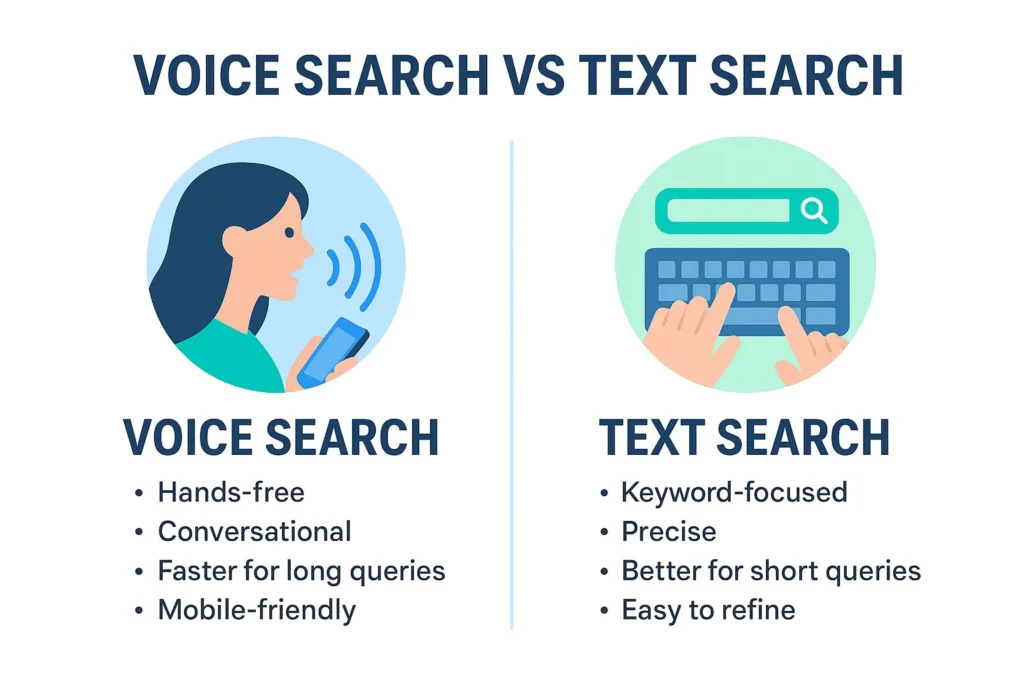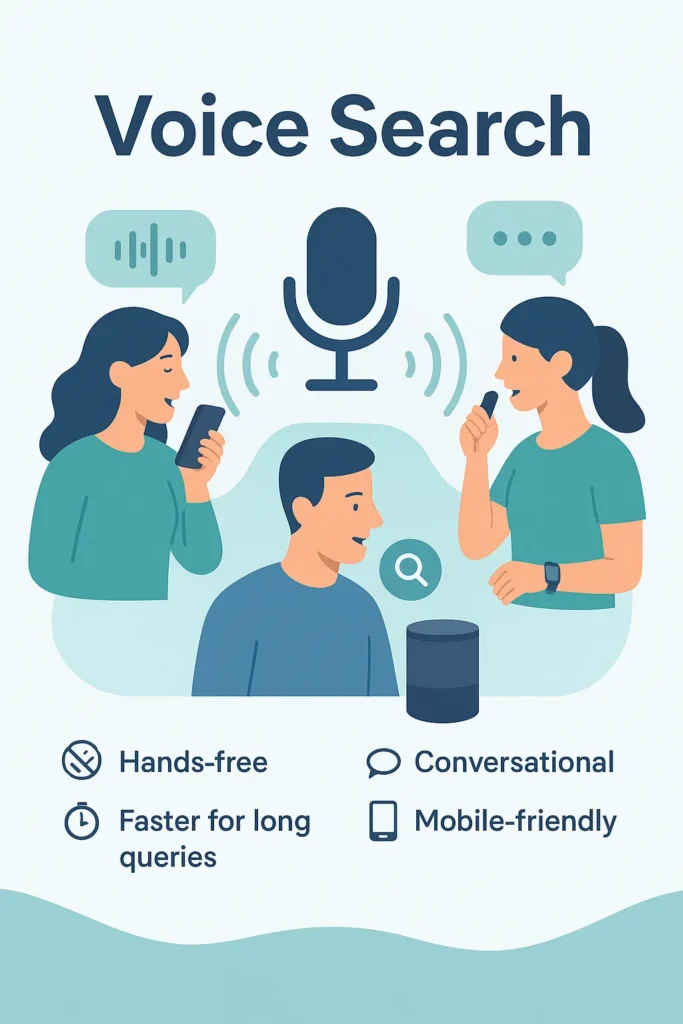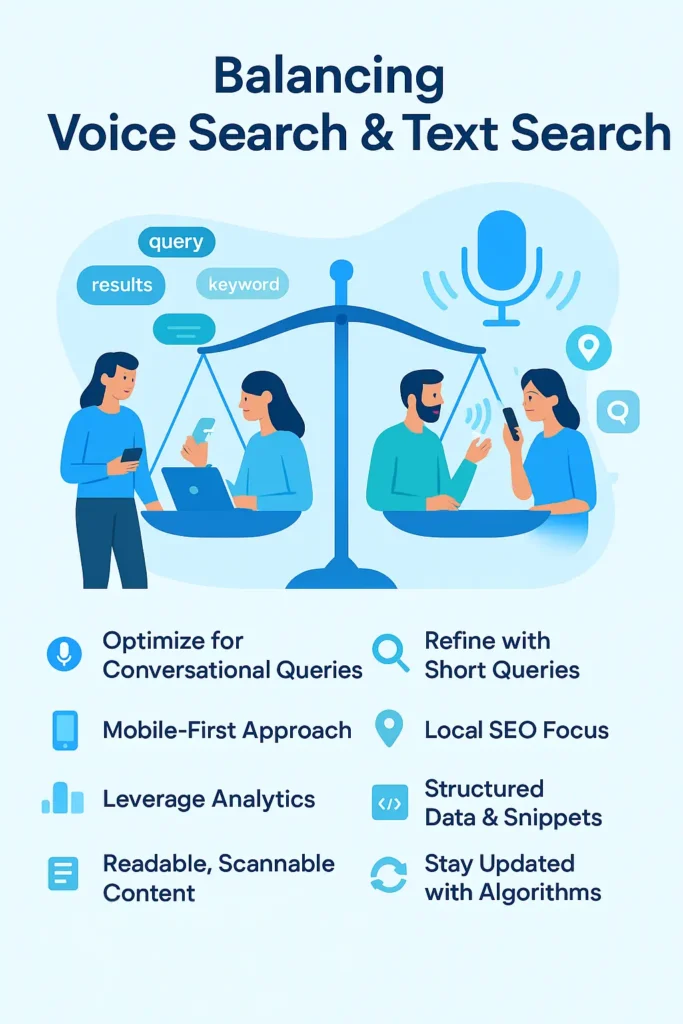Imagine this: you’re driving on the highway and you ask Alexa for the nearest restaurant. Moments later, you stop the car to compare the ratings of three options on your phone, which Alexa just provided.
You speak, and Siri and Alexa respond. Typically, voice assistants offer speed and accuracy. In contrast, text search allows for deeper research, enabling comparisons and the use of filters.
Welcome to the era of the search revolution, where convenience meets depth!
Table of Contents

Why Voice Search vs Text Search Matters In Today’s Digital World
Emerging advancements in the digital world have made both voice search and text search an indispensable part of digital lives.
- Text search is the traditional method of typing keywords or phrases into a search engine like Google.
- Voice search method uses a speech recognition technology and performs searches by speaking into a device.
The search trend is continually evolving, marking a fundamental shift in how we engage with information. It is essential to understand when and what tool to use for increased efficiency.
That’s exactly what you will learn in this blog.
The Rise of Voice Search: A Historical Overview
- 1950s- Researchers started their experimentation with computerised speech recognition systems.
- 1960s– Development of IBM’s Shoebox in 1962, which recognized a limited set of spoken words.
- 1980-1990s- Continuous speech recognition models like DragonDictate and HMMs (Hidden Markov Models) emerged.
- 1994 – The first smartphone and natural assistant, Simon, was born from IBM.
- 2008- Google’s voice assistant was created through mobile app voice search.
- The rise of voice assistants in the 2000s– Powerful algorithms, advanced processing power, and large datasets led to the birth of voice assistants like Siri by Apple(2011), Watson by IBM(2011), Google Now(2012), Amazon’s Alexa(2014), and Microsoft Cortana(2014).
- 2015 onwards– Smart home devices named Echo were launched with steady improvements in natural language understanding and machine learning.
Today, voice assistants are continuously evolving with AI advancements to provide more natural and context-aware interactions.
Current Adoption Rates Of Voice vs Text Search
Let’s see what’s really happening under the hood!
💡 Worldwide, the adoption rate of voice assistants was 4.2 billion in 2020, 8.4 billion in 2024, and is estimated to reach 70-80% in the next few years.

According to usage stats by market.us scoop, voice search is a prominent platform due to customer desires for hands-free technology and the growing AI integration of voice assistants into everyday apps.
Example: A Typical Voice Query
⏰ “Set an alarm for 6 AM.”
🤳“Remind me to call mom at 5 PM today.”
Why Text Search Remains Traditional And Relevant
As per Google search statistics 2025, Google processes over 3.5 billion text searches daily and millions every minute.
However, not all search methods are created equal, and it depends solely on the user’s search query.
The real magic lies in ranking relevance, going beyond the keyword matching and analysing the content of documents, which the text-search provides.
How People Use Text-Based Search Today
Text-based search is the primary way for people to quickly access information across various digital platforms, often enhanced by AI to improve accuracy and relevance.

Text-based searches are widely used in search engines, E-Commerce sites, social media platforms, internal website searches, knowledge bases, help centers, E-mail, document management, academic databases, and in research databases.
Benefits of Text Queries
✔️ Precision and specificity-Specify exactly and get more precise results.
✔️ Ease of use- Users can simply type the keywords or questions.
✔️ Multiple results- Enables rapid retrieval of information with multiple relevant results.
✔️ Easily accessible to all users, compatible, and cost-effective.
✔️ Research focused
Examples of text queries
🍴 “What are 5 quick ways to measure micronutrients in my everyday meal?”
🦴“Suggest me the top brands for dog food based on user ratings”
Voice Search vs Text Search: The Key Differences
| Aspect | Text Search | Voice Search |
| User experience | Emphasizes more precise, concise, keyword-based. | Emphasizes natural, conversational interactions. |
| User type | Users type their queries using an input device. | Users speak their queries using microphon. |
| Context Understanding | Better at understanding detailed phrases or keywords for in-depth searches. | Better at understanding natural language and casual context. |
| Query-length | Depends on keywords, abbreviations, or phrases. | Suitable for quick, hands-free queries. |
| Input Method | Typed words | Spoken words (speech recognition technology) |
| Device Preference | Desktop, iPad, laptop, smartphonewith a keypad | Smartphone with voice assistants, smart speakers. |
Search Trends Shaping the Future
👉 Smartphones have become the main device to use to search trends for almost everything.
👉 Multimodal search involving text, voice, and visual, based on user experience.
👉 Local SEO significantly impacts visibility for location-based “Near me” searches.
👉 With growing preferences for hands-free searches, and networking, the market is shifting towards advanced AI-powered voice assistants, which can contextualise responses and will make interactions human-like.
👉 There is a shift in demographics with the rise of AI-driven and generative search engines.

With general awareness, millennials,
Gen Zs, and households with a good amount of income are adopting voice technology at a faster rate than others.
How to Optimize For Both Voice And Text Search
Technical SEO For Voice Search:
To optimize for voice search, consider the following strategies:
- Incorporate conversational keywords and natural language queries that people normally speak.
- Focus on question words like “how, what, where, when”
- Creating FAQ (Frequently asked questions) style content on the respective niche and addressing common voice search queries.
- opt for conversational search optimization by using location-specific keywords along with the basic NAP (Name, address, phone number) details.
- Focus on being selected as a featured snippet by structuring your content to answer specific questions clearly.
- Improve website speed and implement schema markup for search engines to understand your content better.
- Make your site mobile-friendly.
- Attract more people with a prompt local SEO optimization.
Content Strategy For Text Search:
- Conduct keyword research through various keyword research tools.
- Use relevant long-tail, short-tail keywords, and phrases that your target audience is looking for.
- Create high-quality, structured content, and incorporate the targeted keywords.
- Optimize on-page SEO by incorporating primary keywords in Title tags, meta descriptions, Headings (H1, H2, H3), and URL structure.
- Focus on increasing authority and search engine rankings by building backlinks naturally from reputable sites.
- Prioritize relevance and authority of linking sites.
- Optimize for featured snippets by using bullet points, numbered lists, tables, and concise answers appropriately.
- Update your content regularly and implement internal linking.
Read our Beginner SEO guide: How to Rank on Google in 2025.
Best Practices for Balancing both
Voice Search and Text Search
💡Tailor your content by understanding the user intent and addressing both types of queries precisely.
💡Incorporate long-tail keywords, question-based keywords, and conversational keywords.
💡Design relevant, structured content and FAQ pages that can directly answer common questions quickly.
💡Implementing rich snippets will improve visibility in both the search results.
💡Ensure your website enhances user experience by focusing on local SEO and is mobile-friendly, responsive, and fast-loading.
💡Monitor using analytical tools to identify keywords and queries that are driving traffic.
💡Structure your content based on emerging voice and text search patterns.
💡Prioritize content readability so that it becomes easy to scan, balancing both search users.
💡Focus on staying updated with the Search Engine Algorithm changes.

The demands of both voice search and text search can be met by creating a thorough content and SEO strategy while keeping an eye on informational and keyword-focused requirements, guaranteeing optimal exposure and engagement.
Also, have you heard of Answer Engine Optimization (AEO)? Read our latest blog here.
FAQs : Voice Search Vs Text Search
Is voice search replacing text search?
Voice search is expanding, but it is not replacing text search. Both methods coexist, serving different situations and user needs.
How do I optimize my blog for voice queries?
Optimising your blog for voice queries can be done by incorporating conversational language, FAQs-based content with long-tail keywords, optimising featured snippets, and local SEO.
Which industries benefit most from voice search?
Industries that rely on local searches, customer engagement, and quick information retrieval benefit most from voice search, like E-commerce, local services and restaurants, travel and hospitality, media, and education.
A Quick Recap
The importance of search trends has been brought to the fore.
Preparing for both search methods is highly crucial, as they give the following benefits:
✔️️wider audience
✔️️higher engagement
✔️️boosts search engine rankings
✔️️increases conversion rate
A remarkable website is the first impression of any brand, and it has become imperative to stay effective and competitive.
Final Thoughts
Hope this blog helped you to embrace the new era of search intelligence effortlessly.
Unlock your website’s full potential by optimizing it for all the types of search trends today!
Don’t know where to start, don’t worry.
Subscribe to Digistir360 for more digital marketing insights and watch your online presence shine!
